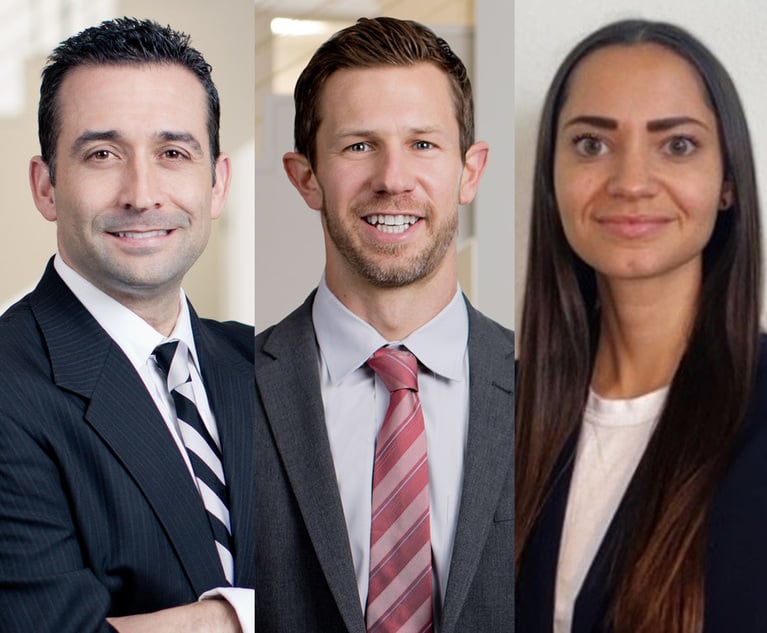ABA's Tougher Bar Pass Rule for Law Schools Applauded, Derided
The American Bar Association's new standard could increase pressure on jurisdictions like California with high cut scores to lower that threshold. It could also add momentum to the burgeoning movement to overhaul the bar exam itself.
May 21, 2019 at 01:57 PM
4 minute read
The original version of this story was published on Law.com

Three days after the American Bar Association decided to toughen the bar passage standard for law school accreditation, legal educators have sharply diverging views on what the new rule will mean and how things might change—or not.
The Council of the Section of Legal Education on Friday adopted a long-debated rule change that reduces the time—from five years to two years—that schools have to get at least 75 percent of their graduates to pass the bar exam.
Proponents say the ABA rightly has cracked down on underperforming campuses, while opponents argue that the change will exacerbate the uneven playing field between schools in different jurisdictions and imperil diversity efforts.
What's clear, however, is that the ABA was responding to the growing pressure for law schools to graduate students who can pass the all-important test, given the record number of exam failures in recent years.
Southwestern Law School dean Susan Westerberg Prager said that the failure of the new standard to account for different exam cut scores across the country disadvantages schools in jurisdictions such as California that have relatively high thresholds.
“Even those of us in California who will meet the new standard, as Southwestern will, suffer negative effects, because the national comparisons published by the ABA and used in rankings paint a misleading picture,” she said. “Of course people will assume that schools in states with low pass rates are 'less good' than schools which are in reality weaker but are located in states with high or higher bar pass rates.”
Others, including Pepperdine University law professor Derek Muller, predict that some lower-performing schools will make adjustments to try and up their bar passage rates but that the new standard won't spur a sea change throughout legal education.
“I won't expect anything too dire,” Muller wrote on his blog, Excess of Democracy. “While it's safe to say that 30 or so law schools have something to worry about, a much smaller number are facing existential threats to their schools.”
The heat of the debate over the bar pass standard has cooled significantly in recent months as many opponents anticipated that the council would move forward with a tougher standard that was twice rejected by the ABA's House of Delegates.
“I think people had already said what they were going to say about it,” said Law School Admission Council president Kellye Testy, noting that few people attended the Council's May 17 meeting in Chicago or submitted new letters in support or opposition of the change.
In addition to reducing the compliance time to two years for 75 percent of their graduates to pass the bar, the new standard eliminates a provision that permitted schools to meet the standard by having a first-time bar pass rate within 15 percent of the average within their jurisdictions. Also under the old rule, schools were required to report bar outcomes for only 70 percent of each graduating class.
The new rule eliminates the first-time pass rate provision and requires schools to report outcomes for all graduates. If schools miss the 75 percent pass rate cut, they could lose their ABA accreditation.
Recent bar exam data from the ABA showed that 23 schools would have failed to meet the new standard based on results from the class of 2016.
William Wesley Patton, a lecturer at the University of Southern California Gould School of Law whose analysis of the bar pass data concluded that the 49 schools at risk of missing the new standard enroll 37 and 35 percent of the nation's African American and Hispanic law students, said the ABA council could have other goals in mind.
“Either the ABA Council simply ignored the clear empirical evidence that the new bar standard will decrease diversity in the bar, or it passed the new standard with the hope that states, like California, that have unreasonably high bar cut scores will lower those metrics in order to ameliorate the Council's action,” Patton said.
Added pressure on jurisdictions with high bar exam cuts scores to lower them is one possible outcome of the new rule, several observers said. California, which has the highest cut score in the country at 144, likely will not want to see the ABA accreditation of some of its longstanding schools threatened, they said.
|This content has been archived. It is available through our partners, LexisNexis® and Bloomberg Law.
To view this content, please continue to their sites.
Not a Lexis Subscriber?
Subscribe Now
Not a Bloomberg Law Subscriber?
Subscribe Now
NOT FOR REPRINT
© 2025 ALM Global, LLC, All Rights Reserved. Request academic re-use from www.copyright.com. All other uses, submit a request to [email protected]. For more information visit Asset & Logo Licensing.
You Might Like
View All
LSAT Administrator Sues to Block AI Tutor From Using ‘Famous, Distinctive’ Test Prep Materials
3 minute read
Some Elite Universities Favor Wealthy Students in Admissions Decisions, Lawsuit Alleges
5 minute read
How Uncertainty in College Athletics Compensation Could Drive Lawsuits in 2025
Trending Stories
- 1Special Series Part 4: The Statutory Guardrails Impermissibly Bind Future Legislatures
- 2New York Court of Appeals Blocks Trump Attempt to Stay Friday Sentencing
- 3'Self-Diagnosed Nickel Allergy' Fails to Find Success in Med-Mal Suit, 8th Circuit Rules
- 4Eversheds Sutherland Adds Hunton Andrews Energy Lawyer With Cross-Border Experience
- 5Balancing Judicial Authority: Understanding Sanctions, Severance, and Interferences
Who Got The Work
Michael G. Bongiorno, Andrew Scott Dulberg and Elizabeth E. Driscoll from Wilmer Cutler Pickering Hale and Dorr have stepped in to represent Symbotic Inc., an A.I.-enabled technology platform that focuses on increasing supply chain efficiency, and other defendants in a pending shareholder derivative lawsuit. The case, filed Oct. 2 in Massachusetts District Court by the Brown Law Firm on behalf of Stephen Austen, accuses certain officers and directors of misleading investors in regard to Symbotic's potential for margin growth by failing to disclose that the company was not equipped to timely deploy its systems or manage expenses through project delays. The case, assigned to U.S. District Judge Nathaniel M. Gorton, is 1:24-cv-12522, Austen v. Cohen et al.
Who Got The Work
Edmund Polubinski and Marie Killmond of Davis Polk & Wardwell have entered appearances for data platform software development company MongoDB and other defendants in a pending shareholder derivative lawsuit. The action, filed Oct. 7 in New York Southern District Court by the Brown Law Firm, accuses the company's directors and/or officers of falsely expressing confidence in the company’s restructuring of its sales incentive plan and downplaying the severity of decreases in its upfront commitments. The case is 1:24-cv-07594, Roy v. Ittycheria et al.
Who Got The Work
Amy O. Bruchs and Kurt F. Ellison of Michael Best & Friedrich have entered appearances for Epic Systems Corp. in a pending employment discrimination lawsuit. The suit was filed Sept. 7 in Wisconsin Western District Court by Levine Eisberner LLC and Siri & Glimstad on behalf of a project manager who claims that he was wrongfully terminated after applying for a religious exemption to the defendant's COVID-19 vaccine mandate. The case, assigned to U.S. Magistrate Judge Anita Marie Boor, is 3:24-cv-00630, Secker, Nathan v. Epic Systems Corporation.
Who Got The Work
David X. Sullivan, Thomas J. Finn and Gregory A. Hall from McCarter & English have entered appearances for Sunrun Installation Services in a pending civil rights lawsuit. The complaint was filed Sept. 4 in Connecticut District Court by attorney Robert M. Berke on behalf of former employee George Edward Steins, who was arrested and charged with employing an unregistered home improvement salesperson. The complaint alleges that had Sunrun informed the Connecticut Department of Consumer Protection that the plaintiff's employment had ended in 2017 and that he no longer held Sunrun's home improvement contractor license, he would not have been hit with charges, which were dismissed in May 2024. The case, assigned to U.S. District Judge Jeffrey A. Meyer, is 3:24-cv-01423, Steins v. Sunrun, Inc. et al.
Who Got The Work
Greenberg Traurig shareholder Joshua L. Raskin has entered an appearance for boohoo.com UK Ltd. in a pending patent infringement lawsuit. The suit, filed Sept. 3 in Texas Eastern District Court by Rozier Hardt McDonough on behalf of Alto Dynamics, asserts five patents related to an online shopping platform. The case, assigned to U.S. District Judge Rodney Gilstrap, is 2:24-cv-00719, Alto Dynamics, LLC v. boohoo.com UK Limited.
Featured Firms
Law Offices of Gary Martin Hays & Associates, P.C.
(470) 294-1674
Law Offices of Mark E. Salomone
(857) 444-6468
Smith & Hassler
(713) 739-1250







